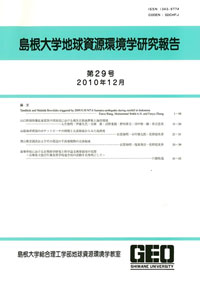島根大学総合理工学部地球資源環境学教室
ISSN:1343-9774

number of downloads : ?
Use this link to cite this item : https://ir.lib.shimane-u.ac.jp/3258
Geoscience reports of Shimane University 19
2000-12-25 発行
宍道湖コアSJ96に見られるヌマコダキガイ密集層の古環境的意味 : サンフランシスコ湾の例との比較から
Paleoenvironmental meanings of the brackish-water clam Potamocorbula beds in the sediment core SJ96 from Lake Shinji,southwest Japan−incomparison with the occurrence in SanFrancisco Bay,California,USA−
Takayasu, Katsumi
Research Center for Coastal Lagoon Environments, Shimane University
Tanaka, Hidenori
Research Center for Coastal Lagoon Environments, Shimane University
Sato, Shinichi
Museum, Tohoku University
File
Description
Several layers densely containing the bivalve mollusk Potamocorbula sp. are observed in the sediment core from Lake Shinji.The characteristics of the layers are as scarcely having any fossils except Potamocorbula sp.,most of the shells being juvenile stage of 4 to 5 mm in length and horizons of them overlapping with diatom barren zone.On the other hand,P. amurensis invaded San Fmncisco Bay,Califomia,USA,in 1986 from Asia as veliger larvae in the seawater ballast of cargo vessels and spread throughout the estuary within 2 years.Making reference to the continuous record of the appearance and spread of P.amurensis in San Francisco Bay carried out by the project team of U.S. Geological Survey,the meaning of Potamocorbula layers in the core from Lake Shinji was discussed.
1)The appearance of Potamocorbula sp. in the core from Lake Shinji was related to the appearance of the enclosed low-saline water area of 7800 to 7900 years ago,which was caused by the climate of high precipitation before and after the K-Ah tephra horizon of 7300 Cal Y.B.P.
2)The reason why diatom becomes barren in the beds of Potamocorbula sp. is supposed to be the remarkable effect of filtration of the clam.
3)The swarm occurrence of Potamocorbula sp. in the layers is considered to be a condensation by the repeated mass production of dead shells by the seasonal appearance of anoxic bottom condition and the small amount of sediment supply to the bottom.
In Japan,the habitat of Potamocorbula spp.overlaps with that of Corbicula japonica,one of the most important clams in fishery.lf Potamocorbula spp. invaded Lake Shinji where the highest catch of C.japonica has been recorded in Japan,it can readily be imagined that the economy of this area as well as the ecology in the lake must suffer a great deal of damage.It is fully significant to clarify the mechanism of invasion of Potamocorbula sp.in the past sediments for the prevention and estimation of damage.
1)The appearance of Potamocorbula sp. in the core from Lake Shinji was related to the appearance of the enclosed low-saline water area of 7800 to 7900 years ago,which was caused by the climate of high precipitation before and after the K-Ah tephra horizon of 7300 Cal Y.B.P.
2)The reason why diatom becomes barren in the beds of Potamocorbula sp. is supposed to be the remarkable effect of filtration of the clam.
3)The swarm occurrence of Potamocorbula sp. in the layers is considered to be a condensation by the repeated mass production of dead shells by the seasonal appearance of anoxic bottom condition and the small amount of sediment supply to the bottom.
In Japan,the habitat of Potamocorbula spp.overlaps with that of Corbicula japonica,one of the most important clams in fishery.lf Potamocorbula spp. invaded Lake Shinji where the highest catch of C.japonica has been recorded in Japan,it can readily be imagined that the economy of this area as well as the ecology in the lake must suffer a great deal of damage.It is fully significant to clarify the mechanism of invasion of Potamocorbula sp.in the past sediments for the prevention and estimation of damage.
Other Article
PP. 57 - 64
PP. 101 - 112
PP. 113 - 125
PP. 127 - 133
